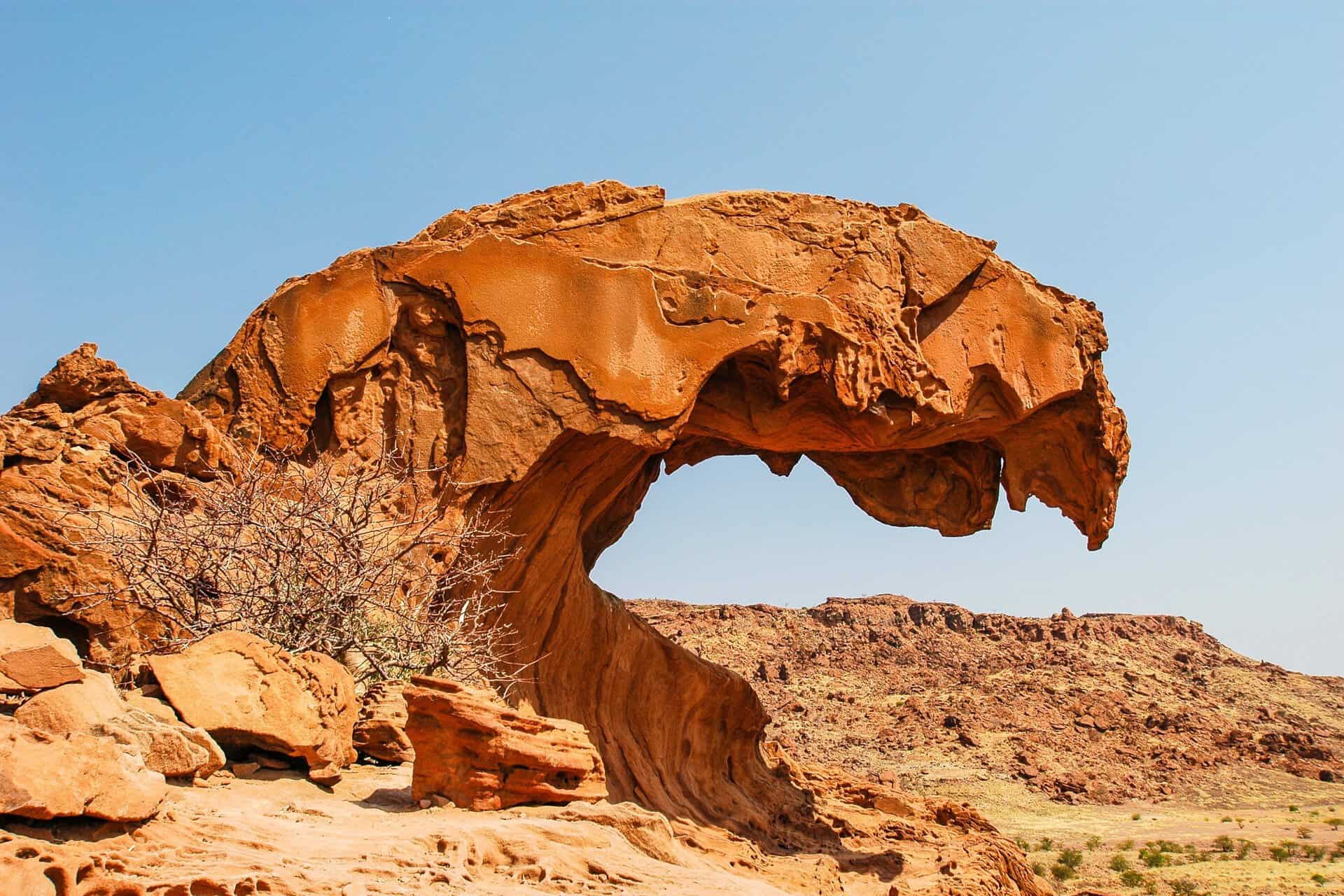Nestled in the heart of Namibia’s rugged landscapes, Twyfelfontein is a site that blends history, culture, and the natural world into one remarkable destination. Known for its rich collection of ancient rock engravings, this UNESCO World Heritage Site stands as a testament to the creativity and resilience of early human societies. Twyfelfontein, or “Doubtful Fountain,” is not just a place of historical significance but also a profound cultural symbol that showcases the deep connection between Namibia’s indigenous people and the land they have inhabited for thousands of years.
The Significance of Twyfelfontein: A Journey Through Time
Twyfelfontein’s recognition as Namibia’s first UNESCO World Heritage Site in 2007 marked a major milestone in the preservation of the nation’s rich cultural heritage. This site, located in the Kunene Region in northwestern Namibia, is home to one of the largest concentrations of ancient rock engravings in Africa. The area is a living museum of human prehistory, with artwork that dates back more than 6,000 years.
The engravings found at Twyfelfontein provide a unique insight into the early lives of the indigenous people of Namibia, particularly the San people, who are often referred to as Bushmen. These rock engravings are not merely decorative; they are deeply symbolic, representing the spiritual and cultural beliefs of the San communities. The artwork depicts a wide array of scenes, including animals, humans, geometric shapes, and abstract designs, reflecting the environment, daily life, and mythologies that were central to the San way of life.
Twyfelfontein’s rock engravings are a rare and valuable glimpse into the ancient past, offering a window into the lives and beliefs of a people who have been displaced and marginalized over the centuries. As one of the most significant rock art sites in Africa, it holds an essential place in the study of prehistoric culture and is a key resource for understanding human history.
The Discovery and Exploration of Twyfelfontein
The history of Twyfelfontein’s discovery is as fascinating as the site itself. While the rock engravings were known to the indigenous communities for centuries, it wasn’t until the 1940s that the site gained recognition in the wider world. In 1946, a researcher named Dr. Hans Schmitz brought the site to international attention. Schmitz, a German archaeologist, conducted the first formal studies of Twyfelfontein’s rock engravings and helped to preserve the area for future generations.
Schmitz’s efforts, coupled with the growing interest in rock art across Southern Africa, led to more extensive archaeological investigations in the decades that followed. These explorations revealed not only the sheer number of engravings at the site but also their incredible diversity and complexity. Scholars have since identified more than 2,500 individual rock engravings scattered across the site, making Twyfelfontein one of the largest and most important examples of rock art in Africa.
The Art of Twyfelfontein: Symbolism and Significance
The rock engravings at Twyfelfontein are striking in their variety and artistic sophistication. Many of the engravings depict animals such as giraffes, elephants, rhinoceroses, lions, and antelopes, highlighting the importance of animals in the daily lives and spiritual practices of the San people. The animals were not only vital sources of food but were also central figures in the San’s religious and mythological beliefs. These creatures were often depicted in stylized forms, with their movements and characteristics captured in ways that demonstrate a deep understanding of the natural world.
One of the most famous engravings at Twyfelfontein is a giraffe figure, which stands out for its size and level of detail. The giraffe is a prominent feature in many of the San people’s spiritual rituals, symbolizing the connection between humans and animals. It is believed that the giraffe, along with other animals, played a significant role in the San’s shamanistic practices, where spiritual leaders would enter trance states to communicate with the animal spirits and seek guidance.
In addition to animals, human figures are also depicted in the rock engravings. These human figures often appear in ritualistic or ceremonial contexts, sometimes portrayed in dance or engaged in interactions with animals. This blend of human and animal imagery suggests a strong belief in the interconnectedness of life and the spiritual world. Geometric patterns, often resembling spirals, lines, and circles, can also be found in the engravings, symbolizing the San’s understanding of the cosmos and their belief in cycles and the natural forces that govern life.
The meaning behind these engravings is still a subject of debate among researchers, as the San people’s languages and oral traditions did not include written records of their beliefs. However, many scholars believe that the engravings are part of the San’s ritualistic practices, intended to invoke spiritual power, guide hunting efforts, and record significant events. The rock art is thought to have served both practical and symbolic purposes, helping to preserve cultural knowledge while also functioning as a medium for communication with the spiritual realm.
Conservation and Preservation of Twyfelfontein
As one of Namibia’s most important cultural landmarks, the conservation of Twyfelfontein is critical to preserving the site for future generations. In 2007, Twyfelfontein was inscribed as a UNESCO World Heritage Site for its exceptional cultural value and its contribution to the understanding of human history. This designation has not only helped raise global awareness of the site but also brought international support for its protection and preservation.
The Namibian government, in collaboration with local communities and international organizations, has undertaken several initiatives to protect Twyfelfontein from the threats of erosion, vandalism, and the encroachment of development. Efforts to preserve the site include limiting public access to certain areas, installing protective measures such as walkways and barriers, and conducting ongoing research to understand the fragility of the rock surfaces and how best to maintain the integrity of the engravings.
Tourism has played a crucial role in the preservation of Twyfelfontein, as it provides funding for conservation efforts and creates an incentive for the local community to engage in sustainable tourism practices. The Twyfelfontein site is carefully managed to ensure that visitors can experience the rock art without causing damage to the engravings. Additionally, local guides, many of whom are indigenous to the area, provide educational tours that not only share the history of the site but also raise awareness about the importance of protecting Namibia’s cultural heritage.
Twyfelfontein’s Role in Namibian Identity
Twyfelfontein holds a profound significance not just for its cultural and historical value, but also for its role in shaping Namibian identity. The site is a source of national pride, representing the rich cultural heritage of the indigenous San people and their enduring connection to the land. For many Namibians, Twyfelfontein symbolizes the strength and resilience of their ancestors, who left behind a legacy that continues to inspire pride and cultural awareness.
The site also highlights Namibia’s commitment to preserving and celebrating its diverse heritage. Namibia is a country with a complex history, shaped by colonialism, apartheid, and the struggle for independence. The recognition of Twyfelfontein as a UNESCO World Heritage Site is a reminder of the importance of cultural preservation and the need to honor the country’s indigenous roots.
Tourism and Economic Impact
Twyfelfontein is one of Namibia’s most popular tourist attractions, drawing visitors from all over the world who are eager to learn about the country’s ancient past. The site offers not only a glimpse into the past but also an opportunity to experience the breathtaking natural beauty of the surrounding landscape. Twyfelfontein is located in the heart of the Damaraland region, an area known for its dramatic desert scenery, mountainous terrain, and unique wildlife, including desert-adapted elephants.
The tourism generated by Twyfelfontein has contributed significantly to the local economy, providing jobs and opportunities for indigenous communities. Local guides, craftspeople, and hospitality workers benefit directly from the influx of visitors, while the revenue generated by tourism helps fund conservation and community development initiatives. Sustainable tourism practices are emphasized to ensure that the site’s cultural and environmental integrity is maintained for future generations.
Twyfelfontein is more than just a collection of rock engravings; it is a living testament to the cultural richness of Namibia and the resilience of its indigenous peoples. As Namibia’s first UNESCO World Heritage Site, Twyfelfontein stands as a powerful symbol of the country’s commitment to preserving its heritage while embracing its future. The site’s artistic, historical, and cultural significance continues to draw attention from around the world, making it a key destination for those seeking to understand the depth of Namibia’s past and its enduring legacy. Through continued conservation efforts and responsible tourism, Twyfelfontein will remain a beacon of Namibia’s heritage for generations to come.













